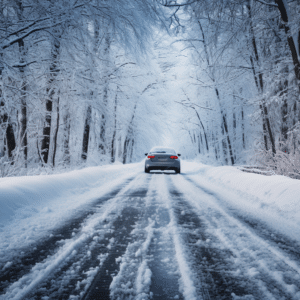
Essential Winter Car Prep: Safety Tips for Cold Roads
Winter’s coming! To stay safe and avoid breakdowns, it is important to get your car prepped. Here are some essential steps to follow:
- Get tires made for icy roads. They offer better traction. Check tire pressure too.
- Test your battery’s health and replace it if needed. Cold weather weakens them.
- Use windshield washer fluid made for freezing temps. Monitor coolant and antifreeze levels, too.
- Change wipers for snow and ice removal. Make sure all exterior lights are working. Clear visibility is key!
Understanding the Importance of Winter Car Preparation
Winter driving requires preparation. Knowing the importance of winter car prep can guarantee your safety on icy roads and stop accidents. Winter weather is harsh and unpredictable, so taking steps to protect your car and yourself is a must.
Tires should be suitable for snowy and icy roads. It’s wise to switch to winter tires for better traction and grip. Tire pressure needs monitoring, as it drops in cold temperatures. Inflated tires improve performance and fuel efficiency.
Checking the vehicle battery is vital. Cold temperatures can reduce a car battery’s performance. An old or weak battery may not start in freezing temperatures, leaving you stuck. Testing the battery before winter begins minimizes the risk of breakdowns and delays.
Other car components must be taken care of in winter. Check fluid levels, like antifreeze, engine oil, and windshield washer fluid. Use antifreeze with the right concentration to avoid freezing. Wiper blades designed for icy conditions help maintain visibility in snowstorms.
According to a study by Consumer Reports Magazine, preparing your car for winter driving boosts safety and performance. Installing winter tires, checking the battery and fluids keeps you safe and increases your vehicle’s longevity.

Checking and Maintaining Tires
Maintaining your tires is a must for winter driving safety. Here are 3 key points to think about:
- Inspect tread depth: Measure it accurately with a gauge – should be at least 3/16 of an inch for good traction on slippery roads.
- Check tire pressure often: Cold weather can cause it to drop which affects vehicle handling and performance. Use a reliable tire pressure gauge and fill up to the correct level.
- Rotate tires for even wear: This will help them last longer and provide better grip on icy or snowy surfaces, improving overall safety.
Also, don’t forget to check the sidewalls for bulges or cuts. These can lead to sudden blowouts, especially in cold weather.
For optimal winter performance, switch to winter tires. They offer better grip due to rubber compounds and tread patterns.
For better results, remember these tips:
- Maintaining appropriate tread depth helps displace water, snow, and slush, reducing hydroplaning risks.
- Proper tire pressure improves steering responsiveness, even wear, and fuel efficiency in cold weather.
- Rotating your tires regularly keeps weight distributed evenly, providing better stability and traction.
- Winter tires have special design features, like sipes and deeper grooves, that maximize contact with road surfaces, giving enhanced traction in icy or snowy conditions.
If you follow these suggestions, your tires will be ready for winter driving, helping keep you safe.
Checking and Replacing Fluids
Don’t make the same mistake as one customer who, on a snow-filled day, experienced a car breakdown due to a lack of antifreeze. You can avoid this! To ensure your car is ready for winter, follow these 6 steps:
- Check the coolant level: Make sure it’s at the recommended level.
- Inspect the oil: Check the oil level and quality.
- Examine the transmission fluid: Look for any signs of leakage or low levels.
- Inspect power steering fluid: Ensure there are no leaks.
- Check brake fluid: Make sure it is at the appropriate level.
- Inspect windshield washer fluid: Fill it with a winter-specific solution.
And don’t forget to check other fluids too – like battery electrolyte levels, wiper fluid, and antifreeze. Regular maintenance is key for a safe winter driving experience. It also increases your vehicle’s longevity. So, check and replace fluids before winter and stay safe!
Ensuring Proper Battery Health
Having a healthy car battery is vital for winter driving. Here’s what you should do:
- Check the battery’s charge level regularly to avoid breakdowns.
- Clean the terminals and cables to prevent corrosion.
- Look out for damage or leakage, as these can affect performance.
- Use a charger or maintainer when your car’s not in use to keep it ready.
Remember: these steps will help keep your battery healthy and reduce the risk of it failing. Taking care of your car’s battery is key to a safe winter drive.
Also, it’s wise to park your car in a garage or cover it when it’s freezing outside. This will protect the battery and help it last longer.
Now, here’s an interesting fact about battery care. During WWII, soldiers had trouble with their vehicle batteries in cold weather. To fix this, technicians made insulated covers for the batteries, allowing them to work properly even in freezing temperatures. This invention made military vehicles much more reliable in winter.
Checking and Replacing Wiper Blades
Ensuring your car is ready for winter driving is essential and replacing your wiper blades is necessary. Visibility is key for safe, comfortable driving, especially in rain, snow, or sleet. Ignoring wiper blades can cause reduced sight and a higher risk of accidents.
To check and replace your wiper blades, try these four steps:
- Inspect the blades: Examine them carefully for any damage like cracks, splits, or uneven edges.
- Check if they work properly: Turn them on and watch their movement. Ensure they clear the windshield without streaks. If you see skipping or smearing, replace them.
- Choose the right replacements: Read your car’s manual or ask a professional to find the size and type of wipers that work with your car.
- Install new ones: Detach the old ones and attach the new ones using the instructions.
By regularly replacing your wiper blades you can maximize visibility on winter roads. Clear windshields protect you and other drivers.
Safety should always be your priority when driving in challenging weather. Don’t let bad blades stop you from reacting quickly to potential hazards.
Take a few minutes now to inspect and replace your wiper blades. Don’t wait until it’s too late to get new ones. Now is the time to stay safe on winter roads!
Preparing the Exterior of the Car
It’s crucial to prep your car’s exterior for winter driving. Ignoring it can lead to visibility, traction, and vehicle damage problems. Here’s a 5-step guide to help you out:
- Check your tires’ tread depth and condition. You may need winter-specific tires or tire chains for snowy terrain.
- Test your exterior lights. Darkness is common in winter, so proper lighting is key for safety and visibility.
- Replace old windshield wipers. Snow and ice make it hard to keep a clear view.
- Put on a protective wax or sealant coating. It’ll shield the paint from salt, ice, and grime.
- Clean and treat rubber seals with a mild detergent solution. Then apply silicone-based protectant to prevent them from freezing/cracking.
Plus, don’t forget regular maintenance like checking fluid levels and inspecting the undercarriage. Don’t wait! Winter weather can be unpredictable, so be proactive and avoid any bad consequences. With these steps, you can drive confidently during winter and enjoy the season.
Equipping the Car with Winter Essentials
Winter driving can be dangerous if you don’t have the right items. Equip your car with these essentials:
- Winter tires
- An ice scraper and snow brush
- An emergency kit
- Tire chains or snow socks
Also, check the battery, brakes, wipers, lights, and fluids regularly. Make sure they are all accessible so you’re prepared if something happens. Don’t forget – do this before the first snowfall! Be safe, not sorry.
Adjusting Driving Habits for Winter Conditions
Driving in winter can be tough and risky if not done correctly. Adapting your driving habits is key for staying safe. Here’s a four-step guide to help you be a pro at driving in winter:
- Slow down: Slowing your speed is critical during winter. This gives you better control and more time to react to any surprises or slippery surfaces.
- Increase following distance: Keep a good distance between you and the car in front, especially on icy or snow-covered roads. This gives you enough room to stop safely and dodge rear-end collisions.
- Smooth acceleration & braking: Abrupt acceleration and braking can make your wheels spin or lock up on slippery grounds. Use gradual pressure for accelerating and braking so the tires can be in control.
- Be aware of road conditions: Check weather forecasts and stay updated on road conditions before leaving. Avoid routes with ice patches or heavy snowfall to reduce the risk of accidents.
Plus, consider these other tips:
- Ensure proper tire maintenance: Make sure your tires have enough tread depth to get good traction on slippery roads. Winter tires are great for cold weather.
- Keep an emergency kit: Have a flashlight, extra clothing, blankets, ice scraper, jumper cables, and a shovel in your car. These are essential if you get stranded in bad weather.
By adjusting your driving habits and following these tips, you can reduce the risks of winter driving. Safety is very important when driving in challenging conditions. Stay alert and be ready for whatever obstacles you may face on the wintry roads.

Conclusion
Winter driving can be dangerous. To ensure safety, it’s important to prepare your car. Here, we’ve provided tips for winterizing your vehicle.
Visibility is essential when driving in winter. Clear snow, ice, and fog off windows. Make sure headlights, taillights, and turn signals work. Invest in good windshield wipers and antifreeze washer fluid.
An example happened in 2014 in Vermont. A snowstorm left people stranded without power. One resident was prepared with snow tires and emergency supplies. He helped others with transportation and provisions from his prepared car.
Follow our guide for car winterization. Check tire pressure, tread depth, and brakes. Keep an emergency kit. Be proactive and brave winter driving!
Frequently Asked Questions
1. How important is it to prepare my car for winter driving?
Preparing your car for winter driving is essential for your safety and the well-being of your vehicle. Cold weather conditions can affect various components of your car, such as tires, battery, and fluids, which can lead to breakdowns or accidents if not properly addressed.
2. What should I check before driving in winter?
Before driving in winter conditions, check your tires for proper tread depth and inflation. Ensure that your battery is in good condition and fully charged. Also, check the levels of your antifreeze, windshield washer fluid, and engine oil. Lastly, inspect your car’s brake system and ensure all lights are working properly.
3. Should I consider changing to winter tires?
Yes, switching to winter tires is highly recommended. Winter tires provide better traction and control on icy and snowy roads compared to all-season tires. The tread patterns and rubber compounds of winter tires are specifically designed to enhance grip and handling in cold weather conditions.
4. How can I improve my visibility during winter driving?
To improve visibility, make sure your windshield wipers are in good condition and install winter wiper blades designed to combat ice and snow buildup. Apply a winter formula windshield washer fluid that can effectively melt ice and grime. Keep your headlights clean and clear, and consider carrying an ice scraper and a snow brush.
5. Should I keep an emergency kit in my car during winter?
Absolutely. It is essential to have an emergency kit in your car during winter. Include items such as a blanket, extra warm clothing, non-perishable food, water, a flashlight, a first aid kit, jumper cables, a shovel, and a road flare. These items can be crucial if you get stranded or encounter a breakdown.
6. How should I adapt my driving during winter conditions?
When driving in winter, it is important to slow down and maintain a safe distance from other vehicles. Accelerate and decelerate gradually to avoid skidding. Be gentle when steering to prevent sudden loss of control. Pay extra attention to black ice, and always keep the gas tank at least half full to prevent fuel line freeze-ups.
